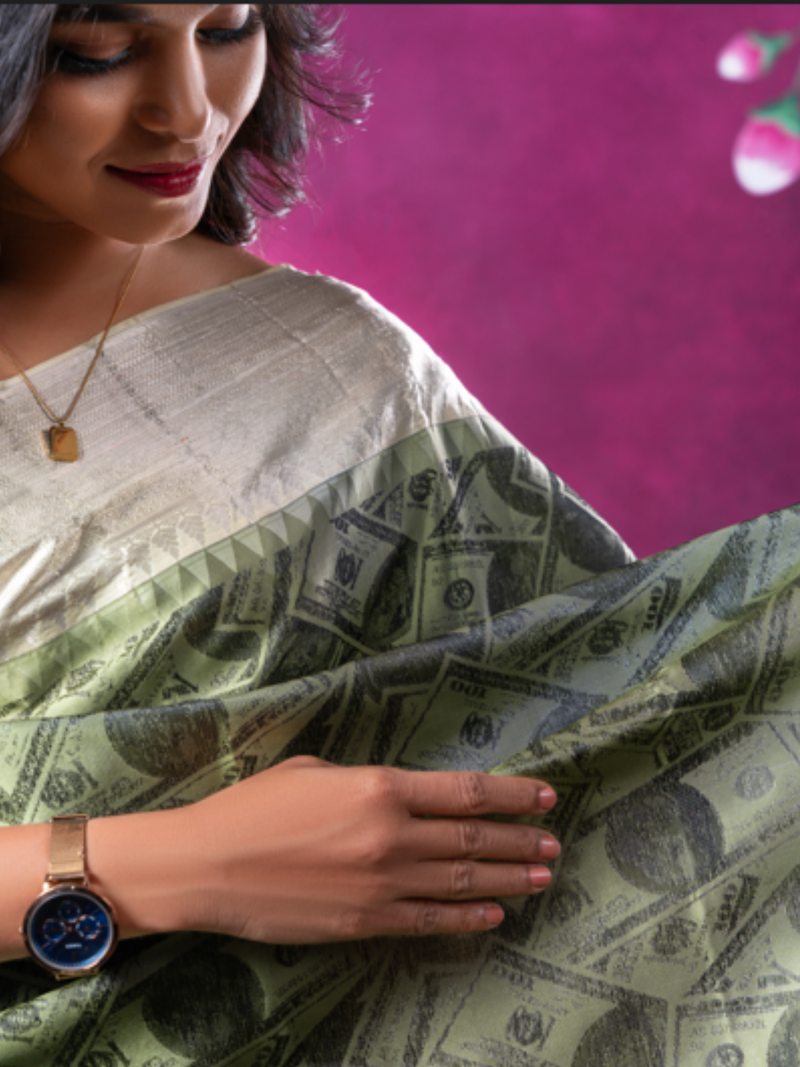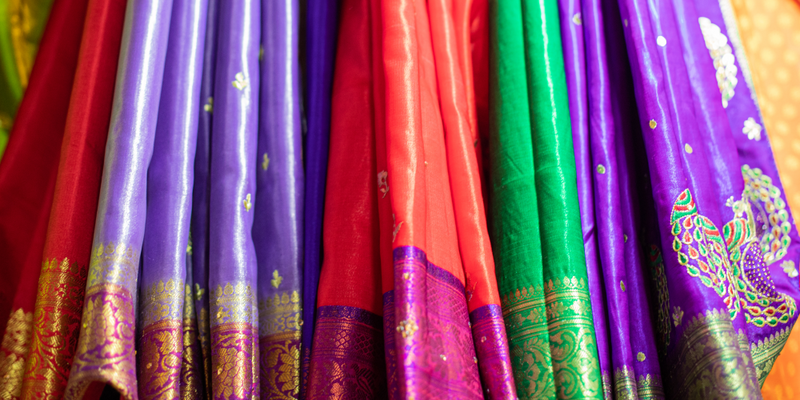The Traditional Beauty of Silk Sarees - A View of Elegance and Artistry
Silk sarees have been highly regarded as some of the most elegant and sought-after garments for ages, dating back through the annals of Indian heritage and culture. Their opulent appeal goes beyond simple beauty; it is a mosaic of ageless traditions, unmatched craftsmanship, and deep cultural importance.Indian silk sarees contain a historical mosaic weaved throughout, with each fold whispering tales of grandeur and legacy. In history of silk sarees shedding light on the exquisite craftsmanship that elevates silk sarees to objects of beauty and prestige in the world of Indian clothing, this exploration aims to unravel the historical significance of these exquisite garments and reveal the fascinating universe of history of saree production in India.
Origin of Silk’s dainty
Cherished for its rich beauty and cultural significance, The history of saree production, the silk production in India holds a special position in rich textile history, dating back thousands of years to a period when careful craftsmanship and ancient traditions coexisted peacefully.
The history of silk sarees extends thousands of years into the past. In the history of saree, silk production in india,The fine threads used in this beautiful trade were first used in the magnificent Mauryan period, about 300 BCE, and they served as the foundation for the creativity and skill of the ancient weavers.
Indian silk sarees were the epitome of refinement and elegance as the medieval era progressed, especially during the splendor of the Gupta Empire's rule, adorning the upper classes of society with their ageless appeal and exquisite appeal. These opulent clothes were more than just clothes; they represented signals of respect and esteem that were timeless and defied societal conventions. They were frequently traded as highly prized gifts of appreciation and deference.
The splendor of the silk industry in India endured through centuries of artistic development and cultural evolution, captivating people's hearts and minds with their exquisite blend of regional styles and techniques that added a kaleidoscope of color and vibrancy to the rich tapestry of India's textile heritage.
This resulted in a symphony of varied patterns, rich hues, and timeless grace that is still treasured and celebrated today. The history of the silk industry in India continues to influence modern fashion, keeping the silk industry vibrant and significant.
The Artisanship Involved in Silk Sarees
The process of making a silk saree is tedious since each stage demands skill and accuracy. The first step in the journey is to select superior silk threads. The finest silk is produced from the silkworm's cocoon, which is painstakingly retrieved and spun into threads.
Dyeing and Spinning: Natural or synthetic dyes are used to color the silk strands. Based on both contemporary trends and historic patterns, the colors were selected. After dying, the threads are spun into yarns.
Weaving: The magic occurs throughout the weaving phase. Expert weavers construct complex patterns and decorations on traditional looms. While some sarees have exquisite designs and borders, others have intricate stitching.
Finishing: Following the weaving process, the silk saree is cleaned, pressed, and occasionally embellished with extra materials like embroidery or zari (gold or silver threads).
The silk production in India is a testament to the enduring craftsmanship and dedication of artisans who have kept the tradition alive for centuries. The history of silk sarees is not just a tale of fashion but also a narrative of skilled labor and artistic excellence.
Popular Silk Saree Types
The history of saree production, silk industry in India is renowned for its enormous assortment, each of which represents a distinct region and its own weaving traditions.
Here are a few of the more popular varieties:
Banarasi Silk Sarees
The history of saree production Banarasi sarees are a representation of artistic grace and cultural grandeur, distinguished by their elaborate patterns and sumptuous zari decorations.Originating in the cultural center of Varanasi, these sarees are famous for their use in traditional rites and lavish weddings.They are a treasured component of every celebratory occasion because of their exquisite zari work, motifs, and peacock designs, which tell a tale of tradition and contemporary together.
Kanjivaram Silk Sarees
In the history of saree production Tamil Nadu's sarees are highly valued for their timeless elegance and are recognized for their superb weaving skills and superior silk.These sarees, which are distinguished by their exquisitely created pallu (end of the saree) and dramatic contrast border, are an embodiment of style and tradition that highlight the elegance of Indian ethnic wear and a legacy rich in craftsmanship.
Mysore Silk Sarees
These sarees are well known for their elegant beauty and are adored by the fashion industry for their luster and delicate texture.A distinctive charm is added by the elaborate borderwork, which sets them apart from standard materials.These sarees are an embodiment of effortless beauty and subtle elegance due to their exquisite workmanship and meticulous attention to detail.
Tussar Silk Sarees
These Tussar silkworm sarees combine exquisite workmanship, unforced beauty, and useful usefulness. They have a natural color and a gentle luster, and they glitter brilliantly in gold.The unique texture and breathability of sarees make them appropriate for a range of events, from formal parties to informal get-togethers. Their lightweight construction adds a degree of sophistication and comfort.These sarees are a flexible and sophisticated option for people who value finer things in life since they represent a timeless elegance that defies fads.
Patola Silk Sarees
Gujarati sarees, which use the double ikat method to showcase expert craftsmanship, are well-known for their geometric designs and vivid hues.
These sarees' symmetrical beauty goes beyond mere materiality; it is the embodiment of centuries-old customs and creative skill. Wearing one of these sarees is a timeless emblem of Gujarati craftsmanship and tradition since it bears a piece of Gujarat's creative legacy in addition to dressing oneself in a work of art.
Each of these types reflects the silk industry in India and its rich history of silk sarees. Indian silk sarees from various regions showcase the diversity and skill present in silk production in India.
Cultural Significance and Modern Trends
For ages, silk sarees have been an integral part of India's rich cultural heritage. These clothes are more than just pieces of clothing; they are symbols of history and a means of conveying grace and beauty. Silk sarees are more than simply clothing; they are treasured cultural artifacts due to the elaborate creativity and workmanship that go into their creation.
Indian silk sarees have historically been worn during significant life events, such as weddings and colorful festivals, as well as notable religious occasions. Their attendance at these kinds of gatherings enhances both the wearer and the occasion by bringing a touch of refinement and tradition. The age-old charm of the saree is found in its capacity to intertwine threads of cultural importance and history with silk.
The fashion industry has seen a resurgence in silk sarees recently, as current designers are bringing traditional shapes together with new styles to appeal to a younger clientele.
The everlasting allure of silk sarees is being preserved for future generations by these designers, who are bringing fresh patterns, hues, and materials into the classic weave.
These classic clothes are being given new life by the combination of old-world charm with contemporary sensibilities, guaranteeing that they will always have a particular place in the hearts and closets of people of all ages and origins.
Conclusion
India's rich textile legacy is embodied in its silk sarees, which combine cultural importance, creative dexterity, and elegance, all made using centuries-old processes. Both fans of modern and classic couture will find these adaptable pieces appealing. Wearing an Indian silk saree is more than just clothes; it's a respected custom and a milestone in life.
It symbolizes a deep past, a tapestry of artistic talent and heritage, and the spirit of a country and its people together by a common respect for customs and workmanship. Shastik Silk Sarees, Located in Coimbatore, Shastik Sarees is a renowned establishment offering a wide range of exquisite silk sarees in india. Known for their rich textures and vibrant patterns, Shastik sarees are crafted with meticulous attention to detail, making them a popular choice for formal occasions and special events. Contact Shastik Sarees now!




